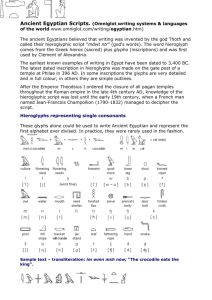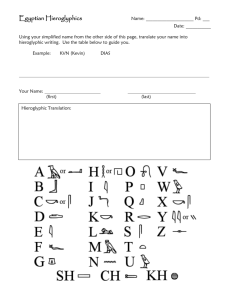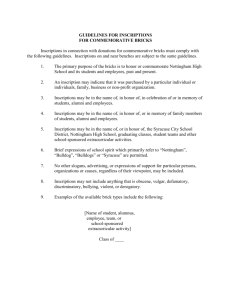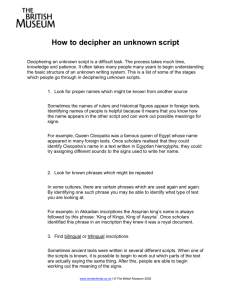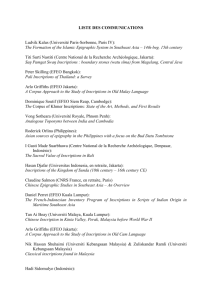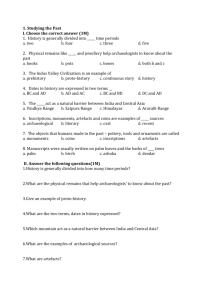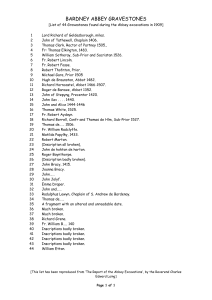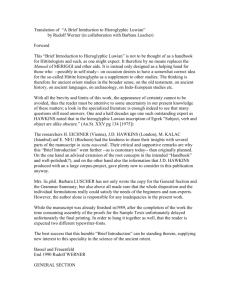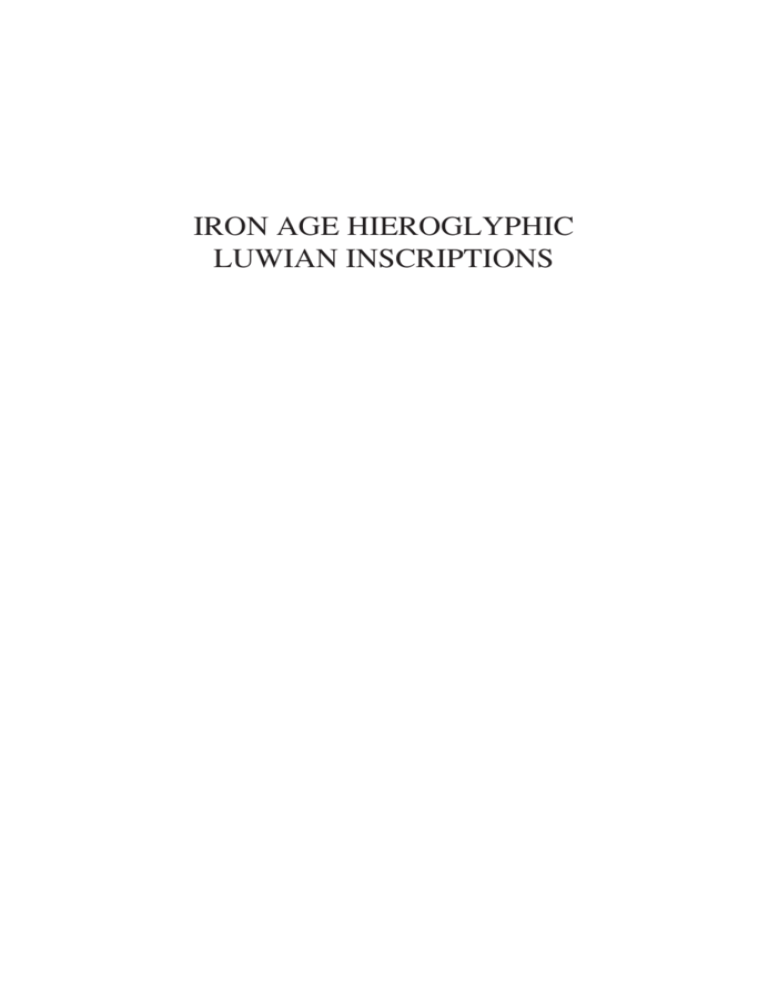
IRON AGE HIEROGlypHIc
luwIAN INscRIptIONs
Writings from the Ancient World
theodore J. lewis, General Editor
Associate Editors
Billie Jean collins
Daniel Fleming
Martti Nissinen
william schniedewind
Mark s. smith
Emily teeter
terry wilfong
Number 29
Iron Age Hieroglyphic luwian Inscriptions
IRON AGE HIEROGlypHIc
luwIAN INscRIptIONs
by
Annick payne
Edited by
H. craig Melchert
society of Biblical literature
Atlanta, Georgia
IRON AGE HIEROGLYPHIC
LUWIAN INSCRIPTIONS
Copyright 2012 by the Society of Biblical Literature
All rights reserved. No part of this work may be reproduced or transmitted in any form
or by any means, electronic or mechanical, including photocopying and recording, or by
means of any information storage or retrieval system, except as may be expressly permitted by the 1976 Copyright Act or in writing from the publisher. Requests for permission
should be addressed in writing to the Rights and Permissions Office, Society of Biblical
Literature, 825 Houston Mill Road, Atlanta, GA 30329 USA.
Library of Congress Cataloging-in-Publication Data
Payne, Annick.
Iron age hieroglyphic Luwian inscriptions / by Annick Payne.
p. cm. — (Society of biblical literature writings from the ancient world ; 29)
Includes bibliographical references and index.
ISBN 978-1-58983-269-5 (paper binding : alk. paper) — ISBN 978-1-58983-729-4
(hardcover binding) — ISBN 978-1-58983-658-7 (electronic format)
1. Luwian language 2. Inscriptions, Luwian. 3. Inscriptions, Hieroglyphic. 4. Anatolian languages. 5. Middle East—Languages. I. Title.
P949.P39 2012
491'.998—dc23
2012033894
Printed on acid-free, recycled paper conforming to ANSI/NISO Z39.48-1992 (R1997)
and ISO 9706:1994 standards for paper permanence.
Contents
List of Abbreviations
vii
Series Editor’s Forword
ix
Acknowledgements
xi
Locations of Hieroglyphic Inscriptions
xii
1. Introduction
1.1. Discovering Hieroglyphic Luwian Inscriptions
1.2. Historical Background
1.2.1. The Hittite Empire: ca. 1680–1200 b.C.e.
1.2.2. The Neo-Hittite States: ca. 1200–700 b.C.e.
1.2.3. Cilicia
1.2.4. Karkamiå
1.2.5. Tell Ahmar
1.2.6. Maraþ
1.2.7. Hama
1.2.8. Tabal
1.3. Biblical Hittites
1.4. The Hieroglyphic Script
1.5. Hieroglyphic Scholarship
1.6. Texts
1.7. Kingship: Religion and Power
2. Texts
2.1. Bilinguals
2.1.1. KARATEPE 1
2.1.2. Ç‹NEKÖY
2.2. Funerary and Commemorative Inscriptions
2.2.1. T‹LSEVET
2.2.2. KARKAMIÅ A1b
2.2.3. KARKAMIÅ A5b
2.2.4. MEHARDE, SHEIZAR
2.2.5. KULULU 4
1
1
2
2
4
4
5
7
7
8
8
9
10
12
14
14
17
19
20
42
45
45
46
47
47
50
v
vi
HIEROGLYPHIC LUWIAN INSCRIPTIONS
2.2.6. MARAÞ 1
2.2.7. TOPADA
2.3. Building Inscriptions
2.3.1. RESTAN, QAL’AT EL MUDIQ, TALL ÅØÏB,
HINES
2.3.2. HAMA 1–3, 6–7
2.3.3. HAMA 4
2.3.4. KARKAMIÅ A11a
2.3.5. KARKAMIÅ A11b+c
2.3.6. KARKAMIÅ A4d
2.3.7. KARKAMIÅ A2+3
2.3.8. CEKKE
2.3.9. KARKAMIÅ A6
2.3.10. KARKAMIÅ A15b
2.3.11. KULULU 1
2.4. Dedicatory Inscriptions
2.4.1. BABYLON 2 and BABYLON 3
2.4.2. BABYLON 1
2.4.3. TELL AHMAR 6
2.4.4. ALEPPO 2
2.4.5. BOHÇA
2.4.6. SULTANHAN
2.5. Miscellanea
2.5.1. TELL AHMAR 1
2.5.2. KARABURUN
2.5.3. BULGARMADEN
2.5.4. ASSUR Letters
52
54
59
59
61
64
66
68
72
73
76
81
84
87
88
89
89
91
94
96
98
102
102
105
107
108
Text Publications
119
Bibliography
121
List of AbbreviAtions
bibLiogrAphiCAL
AfO
Anatolica
AnSt
AOAt
AoF
BSL
cAH
CHLI
DBH
Fs
Gs
HdO
HS
IncLing
JIES
JRAS
JSS
Kadmos
Kratylos
Kubaba
Archiv für Orientforschung. Internationale Zeitschrift für die
Wissenschaft vom Vorderen Orient
Anatolica, Annuaire international pour les civilisations de
l’Asie anterieure, publie sous les auspices de l’institut historique et archeologique néerlandais a Istanbul, Leiden
Anatolian Studies. Journal of the British Institute of Archaeology at Ankara
Alter Orient und Altes testament. Neukirchen-Vluyn
Altorientalische Forschungen
Bulletin du Musée de Beyrouth
the cambridge Ancient History
Corpus of Hieroglyphic Luwian Inscriptions, Berlin: De
Gruyter
Dresdner Beiträge zur Hethitologie, Dresden
Festschrift
Gedenkschrift
Handbuch der Orientalistik. leiden: Brill
see KZ
Incontri Linguistici
Journal of Indo-European Studies
Journal of the Royal Asiatic Society of Great Britain and Ireland
Journal of Semitic Studies
Kadmos. Zeitschrift für vor- und frühgriechische Epigraphik
Kratylos. Kritisches Berichts- und Rezensionsorgan für indogermanische und allgemeine Sprachwissenschaft
Kubaba
vii
viii
HIEROGlypHIc luwIAN INscRIptIONs
KZ
(Kuhns) Zeitschrift für vergleichende Sprachforschung 1–100
(1952–1987), renamed Historische Sprachforschung, abbr.
HS (1988–)
Mitteilungen der altorientalischen Gesellschaft
Münchner Studien zur Sprachwissenschaft
Mitteilungen der vorderasiatischen Gesellschaft
Mitteilungen der vorderasiatisch-ägyptischen Gesellschaft
Orientalia
Oriens. Journal of the International Society for Oriental
Research
Revue hittite et asianique. paris
studies in Ancient Oriental civilizations
Studi micenei ed egeo-anatolico
Die Sprache. Zeitschrift für Sprachwissenschaft
MAOG
MSS
MVAG
MVAeG
Or
Oriens
RHA
sAOc
SMEA
Sprache
Syria
tHeth
tMO
WdO
WZKM
Syria, Revue d’art oriental et d’archéologie, publiée par
l’Institut français d’archeologie du Proche-Orient, Beyrouth
texte der Hethiter
traveaux de la maison de l’orient et de la méditerranée. lyon
Die Welt des Orients
Wiener Zeitschrift für die Kunde des Morgenlandes
signs And symboLs
*(numeral)
*(word)
§
‹›
[ ]
‹…›
[…]
[sign]
<…>
<<…>>
?
?!
!
X, x
sign number after laroche 1960
reconstructed word or form
clause
signs partially preserved
signs not preserved
text damaged
text broken
text restored (as required by context and/or attested in parallel
inscriptions)
erroneous omission
erroneous inclusion
uncertain reading
highly uncertain reading
amended reading
unidentified sign or trace thereof
series editor’s foreword
writings from the Ancient world is designed to provide up-to-date, readable
English translations of writings recovered from the ancient Near East.
the series is intended to serve the interests of general readers, students, and
educators who wish to explore the ancient Near Eastern roots of western civilization or to compare these earliest written expressions of human thought and
activity with writings from other parts of the world. It should also be useful to
scholars in the humanities or social sciences who need clear, reliable translations
of ancient Near Eastern materials for comparative purposes. specialists in particular areas of the ancient Near East who need access to texts in the scripts and
languages of other areas will also find these translations helpful. Given the wide
range of materials translated in the series, different volumes will appeal to different interests. However, these translations make available to all readers of English
the world’s earliest traditions as well as valuable sources of information on daily
life, history, religion, and the like in the preclassical world.
the translators of the various volumes in this series are specialists in the
particular languages and have based their work on the original sources and the
most recent research. In their translations they attempt to convey as much as possible of the original texts in fluent, current English. In the introductions, notes,
glossaries, maps, and chronological tables, they aim to provide the essential
information for an appreciation of these ancient documents.
the ancient Near East reached from Egypt to Iran and, for the purposes of
our volumes, ranged in time from the invention of writing (by 3000 b.C.e.) to
the conquests of Alexander the Great (ca. 330 b.C.e.). the cultures represented
within these limits include especially Egyptian, sumerian, Babylonian, Assyrian,
Hittite, ugaritic, Aramean, phoenician, and Israelite. It is hoped that writings
from the Ancient world will eventually produce translations from most of the
many different genres attested in these cultures: letters (official and private),
myths, diplomatic documents, hymns, law collections, monumental inscriptions,
tales, and administrative records, to mention but a few.
significant funding was made available by the society of Biblical literature
for the preparation of this volume. In addition, those involved in preparing this
ix
x
HIEROGlypHIc luwIAN INscRIptIONs
volume have received financial and clerical assistance from their respective institutions. were it not for these expressions of confidence in our work, the arduous
tasks of preparation, translation, editing, and publication could not have been
accomplished or even undertaken. It is the hope of all who have worked with the
writings from the Ancient world series that our translations will open up new
horizons and deepen the humanity of all who read these volumes.
theodore J. lewis
the Johns Hopkins university
ACknowLedgements
First and foremost, I would like to thank prof. H. craig Melchert who edited
the volume. As always, he has been very generous with his help, answering my
questions, offering advice, encouragement, and corrections. I have also benefitted from countless exchanges with Dr. Ilya yakubovich and am indebted to Dr.
Reinhard G. lehmann for discussion of the phoenician inscriptions. I would
further like to thank Zsolt simon, shai Gordin, and Elifta Fritzsche for kindly
supporting me on numerous occasions. I would also like to thank Marie-Odile
Rousset for providing me with photos of the new tAll ÅØÏB inscription. Any
remaining inconsistencies and inaccuracies are my responsibility alone.
I would also like to thank the team at the society of Biblical literature for
their part in making this book possible. last but not least, I would like to thank
my husband for supporting me in this endeavor.
xi
xii
HIEROGlypHIc luwIAN INscRIptIONs
LoCAtions of hierogLyphiC insCriptions
Sources of Inscriptions
79
13
6
12
Bronze Age
9th century B.C.E.
12th century B.C.E.
8th century B.C.E.
11th century B.C.E.
uncertain date
10th century B.C.E.
53
42
68
78
18
14
74
4
21
77
27
8
59
47
35
29
30
66
67
25
70
32
37
23
60
55
26
56
52
44
39
15
50
43
28
38
54
60
17
24
45
59
31
73
48
51
22
36
40
64
33
41
2
76
12
49
7
1
16
58
46
10
11
71
20
3
5
72
9 75
62
65
69
34
63
1. Adýyaman
2. Afrin
3. Ain Dara
4. Aksaray
5. Aleppo
6. Aliþar
7. Ancoz
8. Andaval
9. Antakya
10. Arslantaþ
11. Asmac›k
12. ‘Azaz
14.
15.
16.
17.
18.
19.
20.
Bohça
Bor
Boybeypýnarý
Bulgarmaden
Burunkaya
Çalapverdi
cekke
21. Çiftlik
23. Darende
24. Domuztepe
25. Eðrek
27.
28.
29.
30.
31.
32.
33.
34.
35.
36.
37.
38.
39.
40.
Emirgazi
Ereðli
Erkilet
Fraktin
Gaziantep
Gürün
Hacibebekli
Hama
Hisarcýk
Ýskenderun
Ýspekçür
Ývriz
Izg›n
Jisr el Hadid
Map used with permission of Harrassowitz Verlag.
41.
42.
43.
44.
45.
46.
47.
48.
49.
50.
51.
52.
53.
54.
55.
56.
57.
58.
59.
60.
Karaburçlu
Karaburun
Karadað
Karatepe
Karkamiå
Kayseri
Kelekli
Kýrçoðlu
Kýzýldað
Kululu
Kürtül
Kurubel
Malatya
Malpýnar
Maraþ
Niðde
palanga
61.
62.
63.
64.
65.
66.
67.
68.
69.
70.
71.
72.
73.
74.
75.
76.
77.
78.
79.
porsuk
Qal‘at el Mudiq
Restan
samsat
sheizar-Meharde
Þ›rz›
sultanhan
suvasa
tall Åøïb
tekirderbent
tell Ahmar
tell tayinat
tilsevet
topada
tuleil
tünp
Veliisa
yalburt
yazýlýkaya
1. introduCtion
1.1. disCovering hierogLyphiC LuwiAn insCriptions
In 1812, the first hieroglyphic luwian inscriptions came to the notice of a modern-day traveller and orientalist, the swiss Johann ludwig Burckhardt—more
than two and a half thousand years after they were executed. Burckhardt, travelling through syria, recorded the following brief note about an inscribed stone he
discovered in the city of Hama, biblical Hamath: “but in the corner of a house in
the Bazar is a stone with a number of small figures and signs, which appears to
be a kind of hieroglyphical writing, though it does not resemble that of Egypt.”1
this description did not generate much interest at the time. Almost sixty
years later, Richard Francis Burton noted:
An important inquiry … made me set out on February 22d for Hums (Emesa),
and Hamáh (Hamath, Epiphaneia), on the northern borders of the consular
district of Damascus. At the latter place … I examined and sent home native
facsimiles of the four unique basaltic stones, whose characters, raised in cameo,
apparently represent a system of local hieroglyphics peculiar to this part of
syria, and form the connecting link between picture-writing and the true syllabarium.2
In 1870, Augustus Johnson and s. Jessup tried in vain to obtain copies of the
stone mentioned by Burckhardt (Friedrich 1969: 128). In 1872, the Irish missionary william wright kindled the turkish governor’s interest in this stone.
with difficulty, wright and Green took plaster casts, and a copy each was sent to
the British Museum (wright 1886: 1–12). the stones themselves (now known
1. “Journal of a tour from Aleppo to Damascus, through the Valley of the Orontes
and Mount libanus, in February and March, 1812,” Travels in Syria and the Holy Land
(london: Murray, 1822). Online: http://ebooks.adelaide.edu.au/b/burckhardt/john_lewis/
syria/chapter3.html.
2. Richard Francis Burton and charles F. tyrwhitt-Drake, Unexplored Syria
(2 vols.; london: tinsley Bros., 1872). Online: http://burtoniana.org/books/1872-unexplored%20syria/unexploredsyria-ocr-vol1.htm.
1
2
HIEROGlypHIc luwIAN INscRIptIONs
as HAMA 1–4) were removed to ‹stanbul Museum in 1877. similar stones came
to light in various places in syria during the 1870s, and among the first to attempt
a decipherment was the British assyriologist A. H. sayce. In a lecture to the society of Biblical Archaeology, given on May 2, 1876, he proposed to use the term
“Hittite” (from Old testament htym, Egyptian ñt’ or Kheta, Assyrian Ñatti) for
the growing corpus of hieroglyphic inscriptions. In 1879, sayce connected the
“Hittite” finds of syria with similar remains discovered in Anatolia. In 1882, he
announced that the Hittites were much more than the small canaanite tribe mentioned in the Old testament, namely, the people of “a lost Hittite Empire.”
Almost fifty years earlier, in 1834, the French explorer charles texier
stumbled across the ruins of what would prove to be the capital city of the Hittite Empire during his search for tavium, an important celtic city. locals had
arrived to find the remains of a vast city, and outside of the city, about half
an hour’s walk away, an ancient rock sanctuary. It has two natural chambers
decorated with figures of deities cut into the rock, their names inscribed in
hieroglyphs. the very beginnings of this hieroglyphic script are still clouded in
obscurity, but the first full length inscriptions were executed as official monuments of the Hittite Empire. while the discovery of hieroglyphic inscriptions
in syria predated modern knowledge of the Hittite Empire, decipherment only
became possible through knowledge of the Hittite language, as documented
on thousands of cuneiform-inscribed clay tablets. to establish the necessary
background, we shall in the following briefly look at the history of the Hittite
Empire—the historical and cultural context of the earliest hieroglyphic inscriptions—and of the ensuing Neo-Hittite states, where the hieroglyphic script
became the only writing medium and experienced its golden age.
1.2. historiCAL bACkground
1.2.1. the hittite empire: CA. 1680–1200 b.C.e.
Hittite History is commonly divided into three longer periods, classified as Old
Kingdom (ca. 1650–1420 b.C.e.), Middle Kingdom (ca. 1420–1344 b.C.e.) and
New Kingdom (ca. 1344–1200 b.C.e.). All these dates are approximations, they
rest on synchronisms and are based on the Egyptian low chronology. the following paragraphs aim to provide a short overview and will therefore only introduce
the most important Hittite kings and events taking place under their reign.
the Hittite Old Kingdom starts with Hattusili I (ca. 1650–1620 b.C.e.),
who rebuilt the city of Hattusa, a Hattian settlement that had been destroyed and
cursed by Anitta of Kuååara around 1700 b.C.e. Hattusili made Hattusa his capi-
INtRODuctION
3
tal, and it is very likely that he named himself after the city. During his reign, he
extended his territory to cover most of Anatolia and northern syria. His grandson,
Mursili I (ca. 1620–1590 b.C.e.) is best known for his military successes, taking
much of northern syria, including Aleppo, and even Babylon. this territorial
gain, however, could not be effectively controlled or maintained. the campaign
had drained the resources of the kingdom, and Mursili was assassinated soon
after his return home. this introduced a period of chaos and internecine strife,
until telipinu (ca. 1525–1500 b.C.e.) stabilized the monarchy and formulated
a legal framework for royal succession in his famous edict. His rule marks the
end of the Old Kingdom, and the earliest hieroglyphic seal, the Iåputahåu seal,
also dates to this time. the Middle Kingdom begins with a period of which we
know comparatively little under what appear to be weak kings. tudhaliya I/II
(whether there were two separate kings of this name remains a topic of scholarly dispute; ca. 1420–1400 b.C.e.) renewed vassal treaties with Kizzuwatna
and regained control of Aleppo. He undertook many campaigns, among others
against Iåuwa in the northeast, and Aååuwa and Arzawa in the west. His reign is
followed by another weak phase, culminating in the sack of Hattusa during the
reign of Arnuwanda I (ca. 1370–1355).
the New Kingdom, also known as Empire period, starts with suppiluliuma I
(ca. 1344–1322) who ruled over Anatolia and northern syria; control was exercised through vassal states and viceroys at Karkamiå and tarhuntassa. Alongside
Egypt, Hatti had become the main power of the ancient Near East, and this
equality was acknowledged in a letter by a pharaoh’s widow (possibly tutankhamun’s), asking suppiluliuma to send her one of his sons to marry, as she refused
to marry someone below her status. such a marriage candidate was indeed sent to
Egypt, but on his way there he was assassinated, thereby instigating a period of
war between Egypt and Hatti.
Mursili II (ca. 1321–1295) campaigned in the west, in particular against
Arzawa and Millawanda (Miletus). In ca. 1275 b.C.e., Muwatalli II (ca. 1295–
1272) fought the Egyptian pharaoh Ramses II at Qadesh, in a dispute over syrian
territories. the battle is amply described in Egyptian sources as a resounding
victory, but as the Hittites kept their control over the disputed areas, the outcome
was more likely a stalemate; the gain, if any, was on the Hittite side. Muwatalli’s reign is further important as the period from which we have the first datable
hieroglyphic inscription, AlEppO 1, a text of talmi-Åarruma of Aleppo (see
Hawkins 2000: 3; 19). Muwatalli’s son, urñi-teååub, acceded the throne as Mursili III (ca. 1272–1266) but was soon deposed by his uncle who ruled as Hattusili
III (ca. 1266–1237). the latter concluded a peace treaty with Ramses II (ca. 1258
b.C.e.), a copy of which is famously on display at the united Nations headquarters in New york. Hattusili’s usurpation introduced the final period of the Hittite
Empire, which was accompanied by internal power struggles. His son, tudhaliya
4
HIEROGlypHIc luwIAN INscRIptIONs
IV (ca. 1237–1209) still ruled as a relatively strong king—and executed quite
a few hieroglyphic inscriptions—yet had to make allowances to Kuruntiya of
tarhuntassa, a vassal king and descendant of Muwatalli, who had a legitimate
claim to the throne of Hattusa. Indeed, it seems likely that tudhaliya’s son, suppiluliuma II, (ca. 1205–?) openly waged war on tarhuntassa, after Kuruntiya
tried to revolt.
1.2.2. the neo-hittite stAtes: CA. 1200–700 b.C.e.
Around 1200 b.C.e., major upheaval and changes affected the ancient Mediterranean and Near Eastern worlds. the region formerly ruled by the Hittite Empire
lost its central administration with the fall of the Empire. Reasons for this collapse are much debated, and it is likely that a combination of various factors
contributed to it. there is evidence of large-scale migration, including burnt and
abandoned cities. Bands of marauding Kaskaeans, attacks of the so-called sea
peoples, famines, and war, especially with tarhuntassa, would all have aided to
destabilize the region, finally leading to the fall of the Hittite Empire. On former
Hittite territory, several new, smaller states emerged. culturally, they were
significantly indebted to the Hittite Empire and are therefore known today as
Neo-Hittite states. some of these new states were already important centers of
power under the Hittite Empire who seem to have survived the disruption around
1200 b.C.e. unscathed.
Hieroglyphic luwian inscriptions survive from the following Neo-Hittite
states: cilicia, Karkamiå, tell Ahmar, Maraþ, Malatya, commagene, Amuq,
Aleppo, Hama, and tabal. It is remarkable that despite coming from such a
large area and over a period of almost five hundred years, the inscriptions are
nonetheless relatively uniform. the language of these inscriptions is a standardized form of luwian propagated by the Hittite kings at Hattusa and imitated by
the Neo-Hittite rulers (see yakubovich 2010a: 72–73). the uniformity of the
inscriptions also suggests that the writing system continued to develop in close
contact between these states, until it perished with the last of the Neo-Hittite
states, ca. 700 b.C.e.
the subsequent paragraphs will provide a brief history of the states relevant
to the texts offered in this volume. Apart from internal information from local
hieroglyphic texts, the most important source for the history of the Neo-Hittite
states are the Assyrian annals.
1.2.3. CiLiCiA
cilicia plays an important role as a source of hieroglyphic inscriptions. there
are two major texts from this area, both phoenician-luwian bilinguals. One of
INtRODuctION
5
them, the inscription KARAtEpE 1, is the longest preserved luwian and phoenician inscription to date. cilicia is situated between the taurus Mountains in
the northwest, the Amanus Mountains in the east and the Mediterranean sea in
the south; it was of strategic importance, controlling Anatolian access to syria.
During the Bronze Age, it was populated by Hurrians and luwians, its main city
Adana is attested as Ataniya. Iron Age Hieroglyphic inscriptions speak of the
city as Adana(wa), phoenician ’dn, while the Assyrian annals distinguish two
regions, the cilician plain or Que, and rough cilicia or Hilakku. the Old testament records that King solomon traded horses with the kings of Que: “Also
solomon’s import of horses was from Egypt and Kue, and the king’s merchants
procured them from Kue for a price” (1 Kgs 10:28; also 2 chr 1:16); however,
it remains questionable whether these passages refer to this Neo-Hittite state.3
Assyrian sources first mention cilicia in the year 858 b.C.e., and provide many
references, most important among these is sargon’s II control of both Que and
Hilakku. Neo-Babylonian and classical sources provide further information for
later periods.
Archaeological investigations, meanwhile, have little to contribute, the
main excavation site is Karatepe, which, besides its valuable inscription, preserves archaeological structures, namely, a small fortress, two city gates, and
walls. According to the hieroglyphic texts, the main Iron Age city was Adana,
but because of continued settlement there, excavation is not likely. there are
only very few indigenous inscriptions from Iron Age cilicia, and these attest two
generations of rulers based at Adana, a King Awarikus/warikas of the house of
Muksas (possibly classical Mopsus), and his successor, the regent Azatiwadas.
Both names have possible equations in Assyrian annals, Awarikus as urikki of
Que, attested for the years 738–732, and 710–709, and Azatiwadas as sanduarri,
king of Kundi and sissu, attested for the year 676 b.C.e.
1.2.4. kArkAmiå
Already an important seat of power under the Hittite Empire, Karkamiå survived
the political changes at the end of the Bronze Age without obvious disruption.
Karkamiå occupies a strategic position at an important crossing of the river
Euphrates, and during the Bronze Age, controlled the Hittite territories in northern syria. For biblical references to Karkamiå, see Jer 46:2; 2 chr 35:20; Isa
10:9. A wealth of Hieroglyphic luwian inscriptions originates from here, dating
to between the eleventh and ninth centuries b.C.e. In 717 b.C.e., Karkamiå was
annexed by the Assyrians, and finally, in 605 b.C.e., destroyed by Nebuchadrezzar.
3. cf. tadmor 1961.
6
HIEROGlypHIc luwIAN INscRIptIONs
In modern times, the site of Karkamiå was first identified in 1876 by
George smith, and representatives of the British Museum recovered important
monuments from 1878–1881. Archaeological excavations took place between
1911–1914 until the outbreak of world war I, resuming in 1920, conducted
by a British team led by sir leonard woolley. Excavations were several times
interrupted by warfare, and for many decades the site lay abandoned as the
syro-turkish border runs through it. Very recently, the area has been cleared of
land mines and excavations resumed in the autumn of 2011. to date, Karkamiå
provides the greatest number of hieroglyphic inscriptions and sculpture of any
single site.
past archaeological work includes a survey of the fortifications and the
excavation of two main areas, namely, the upper levels of the citadel, and the
area of the lower town underneath, where most inscriptions and sculpture were
found. Amongst important structural remains are a temple of the storm God, the
King’s Gate and the Great staircase ascending to the citadel.
the sculpture from Karkamiå offers dating criteria, while indigenous
inscriptions attest several royal families. A line descending from the Hittite king
suppiluliuma I, who installed his son piyassili/Åarri-Kuåuñ as Hittite viceroy
and king of Karkamiå in ca. 1340 b.C.e., seems to have continued unbroken for
at least five generations, unperturbed by the fall of the Hittite Empire. Nonetheless, Karkamiå lost its power over the former Hittite province of syria and was
reduced to a city-state. Karkamiå continued to retain its independence until the
Assyrian conquest in 717 b.C.e. Assyrian annals only attest two kings of Karkamiå, sangara (ca. 870–848) and pisiri (ca. 738–717 b.C.e.), yet, unfortunately,
these cannot currently be reconciled with any of the kings known from luwian
inscriptions; the latter confirm three native dynasties. the earliest is an archaic
group using the by then vacant Hittite title of Great King, possibly because of a
dynastic claim to the royal house of Hatti. Of these early kings, we know the following by name: Kuzi-teååub, X-pa-ziti, ura-tarhunza and tudhaliya(?). Next
came the House of suhis with its rulers suhis I, Astuwalamanzas4, suhis II, and
Katuwas, who ruled before 870 b.C.e. Also attested is a House of Astiruwas,
named after a king called Astiruwas, who was succeeded by the regent yariris,
then Kamanis (son of Astiruwas), [a gap?], sasturas, sasturas’s son (name not
preserved). the house of Astiruwas falls within the gap between sangara and
pisiri, thus possibly ruling ca. 848–738 b.C.e.
4. previously read Astuwatamanzas; following the new readings of yakubovich and
Rieken (2010) this should be amended to Astuwalamanzas.
INtRODuctION
7
1.2.5. teLL AhmAr
tell Ahmar is known from Assyrian sources as til-Barsip, from hieroglyphic
inscriptions as Masuwari. It is situated on the east bank of the river Euphrates,
some 20 km south of Karkamiå, and holds a strategic position as a Euphrates
crossing point. Åalmaneser III took the city in 856 b.C.e. from an Aramean ruler,
Ahuni of Bit-Adini, and renamed it Kar-Åalmaneser. It is not entirely clear how
long til-Barsip had been in the hands of the Arameans, however, luwian control
of the site clearly predated this. there are archaeological remains of buildings
resembling the style of nearby Karkamiå, destroyed by fire; sculptural remains,
too, show stylistic links with Karkamiå, in particular with the suhis-Katuwas
period (tenth to early-ninth century b.C.e.). Both stele fragments and orthostat
blocks used to build stone walls remain.
the inscriptions attest a ruling house with two competing lines. the first
two kings belonged to the family of Hapatilas; next the family of Hamiyatas
provided three kings, until finally power reverted back to the last descendant
of Hapatilas’s family. unfortunately, his name is not preserved. An open question is how the author of the inscription AlEppO 2 (see below, 2.4.4), a certain
Arpas, fits into all of this.
1.2.6. mArAþ
the Neo-Hittite state of Maraþ also shows close links with Karkamiå, and its
rulers may have been linked to the Hittite royal house via the line of tarhuntassa.
Indigenous inscriptions all stem from the ninth century b.C.e. Assyrian sources
refer to a land Gurgum with its capital Marqas in the period 870–711 b.C.e., after
which the area became an Assyrian province. there is very little archaeological
data on the ancient state of Maraþ, as no excavations or surveys have been undertaken. luwian inscriptions speak of Maraþ as the “Kurkumaean city.”
the inscription MARAÞ 1 provides a chronology with seven generations of
rulers ca. 1000–800 b.C.e.; three of which can be identified with rulers known
from Assyrian sources. Another inscription, MARAÞ 8, provides two further
ancestors, yet we do no know whether they also ruled over Maraþ. thus, we can
reconstruct the following dynasty: [Astu-waramanzas, Muwatalis,] laramas I,
Muwizis, Halparuntiyas I, Muwatallis, Halparuntiyas II, laramas II, Halparuntiyas III. Of these, Muwatallis can be identified as Mutalli in Assyrian sources,
mentioned for the year 858 b.C.e. as paying tribute to Åalmaneser III; Halparuntiyas II as Qalparunda, attested for the year 853 b.C.e. as submitting to Åalmaneser;
laramas II as palalam; and Halparuntiyas III as Qalparunda, attested for the year
805 b.C.e. Assyrian sources further mention a king tarhulara for the years 743,
738, 732 b.C.e. who was dethroned and killed by his son Mutallu in 717 b.C.e.
8
HIEROGlypHIc luwIAN INscRIptIONs
this crime was promptly avenged by the Assyrian king sargon II, and Gurgum
annexed.
1.2.7. hAmA
the modern city of Hama appears in the bible as Hamath, in Assyrian texts as
Amat/Ham(m)at. the Neo-Hittite state of Hama provides only a small group of
inscriptions, but gained importance as the earliest site from which hieroglyphic
inscriptions were known, as outlined above (1.1). Excavations took place under
a Danish team from 1931–38 but did not unearth many inscriptions, although
some twenty cuneiform tablets were found. settlement seems to have continued
unbroken from the Neolithic to the Islamic period. In the first millennium b.C.e.,
luwian kings ruled over Hama until they were replaced by Aramaeans ca. 800
b.C.e. Apart from two early inscriptions (see 2.2.4), the texts from Hama were
commissioned by two rulers, urahilina5 (known as Irhuleni in Assyrian annals,
ca. 853–845 b.C.e.) and his son uratamis (ca. 840–820 b.C.e.).
1.2.8. tAbAL
From the state of tabal comes the second largest group of hieroglyphic inscriptions, after Karkamiå. tabal (biblical tubal) is located in the southeast of the
Anatolian plateau, bordering onto the taurus mountains in the southeast, Melid
in the east, cilicia to the south and phrygia to the northwest. tabal consisted
of various small city states. By the eighth century b.C.e. these had merged into
two, tabal proper (Assyrian Bit-Burutaå) to the north and tuwana (classical
tyanitis) to the south. there is little archaeological data on ancient tabal. the
earliest indigenous inscriptions (KIZIlDAÐ-KARADAÐ, BuRuNKAyA)
come from the west, and may date as early as shortly after 1200 b.C.e. In these, a
king Hartapus and his father Mursili, possible descendants of the Hittite kings of
tarhuntassa, claim the Hittite title of Great King. No further inscriptions can be
dated to the following centuries until the eighth century b.C.e.
One differentiates two groups of inscriptions, one from the south (tuwana),
which provides information on a three generation dynasty of tuwana: Muwaharanis, warpalawas (Assyrian urballa, ca. 738–709 b.C.e.), Muwaharanis.
the other group of inscriptions stems from the north (tabal proper), and attests
different rulers, among them the family of tuwatis and his son wasusarmas
(Assyrian sources record the latter as wassurme, ca. 738–730 b.C.e.), as well
as other rulers such as Kurtis (Assyrian Kurti, attested for the years 718, 713
5. previously read urahilina. I follow yakubovich (2010b: 396 n. 9), who analyses
the name as urahilina, luw. “(having) a great gate.”
INtRODuctION
9
b.C.e.?). A particularly late writing style from tabal is shown by the Kululu
lead documents.
Assyrian control of tabal was less firm than on other regions, and particularly the death of sargon destabilized their hold over this area. the end of the
indigenous hieroglyphic tradition therefore seems not to be due to Assyrian
annexation but must have had other reasons. Assyrian texts mention tabal for a
last time in 651 b.C.e. centuries later it reemerges in classical sources under the
name of cappadocia.
1.3. bibLiCAL hittites
It is for purely historical reasons that we speak of “Hittites” and the “Hittite”
language. the Hittites spoke of themselves as “people of the land of Hatti” (the
name given to it by earlier residents of the area, the Hattians), and called their
language “Nesite” after the city Kaneå. But by the time the first remains of this
civilization were rediscovered by modern scholars, any knowledge of the Hittite
Empire had long vanished, and as mentioned above (1.1), the emerging, forgotten civilization was soon linked to Het, ha-hittî, hittîm and hittiyyot. References
in recently deciphered ancient Egyptian and Assyrian texts to a land of ñt’ or
Kheta (Egyptian) or Ñatti (Assyrian) seemed to confirm the link, and the term
“Hittite” is still in use today.
Meanwhile, the question remains how the biblical Hittites fit into what we
now know of the Hittite Empire and her successor states. the biblical Hittites do
not form one homogenous group. At minimum, one can differentiate between
Hittites within and outside of palestine in the biblical references. Most references are to palestinian Hittites, while only five passages refer to Hittites outside
of palestine. the land of these Hittites is shown to extend from the Euphrates
to the Mediterranean sea (Jos 1:2–4; Judg 1:26 refers to the same country), an
area that includes the territory of the Neo- Hittites states in syria and southern
Anatolia. the “Kings of the Hittites” who traded in horses and cavalry (1 Kgs
10:29; 2 chr 1:17; 2 Kgs 7:6) must therefore refer to Neo-Hittite kings, and the
Hittite wives of solomon (1 Kgs 11:1) should also be placed in this context. An
inscription of the Assyrian King Åalmaneser III attests to contact between NeoHittites and Israelites, naming Irhuleni of Hamath and Ahab of Israel as allies
of an anti-Assyrian alliance whom he defeated at the Battle of Qarqar in 853
b.C.e. this suggests a living memory of at the very least the Neo-Hittites of syria
among the authors of Old testament scriptures during the ninth century b.C.e.,
and presumably thereafter.
But the majority of biblical references to the Hittites show them as natives
of canaan (e.g., Gen 15:19–21; Josh 3:10 refer to the Hittites as a tribe of pal-
10
HIEROGlypHIc luwIAN INscRIptIONs
estine; Gen 10:15 states that Heth is a son of canaan). there is no conclusive
evidence that can reconcile this group with any sucessors of the Hittite Empire.
Another possibility would be that the Hittites entered the biblical text as an ideological and literary construct, keeping alive the memory of the historical Hittites.
A final option would be that these Hittites were an immigrant group, possibly
arriving in palestine after the fall of the Hittite Empire, yet there is no material
evidence for this, nor a convincing explanation why such immigrants should be
perceived as indigenous.6
1.4. the hierogLyphiC sCript
the hieroglyphic script is used to record the luwian language with the help
of pictorial signs. these are written “boustrophedon” or “as the ox ploughs,”
alternating their direction from line to line. In structure if not in appearance, the
writing system closely resembles the cuneiform script, distinguishing likewise
three different sign types, logograms, determinatives, and syllabograms. A logogram represents an entire word with just one picture. In its simplest form, the
glyph depicts the object drawn but it may also depict an object associated with
the intended word, such as the king’s hat as a symbol for the king, or a word of
similar sound. Determinatives are signs used to mark words as belonging to a
specific sphere, maybe comparable to using titles such as Mr. and Mrs. to signify
gender, but extending to a number of categories. Many of these we can understand while the logic of others eludes us. syllabic signs are used to represent the
sound of the word written with them; in the hieroglyphic writing system, these
phonetic signs have the structure vowel (V), consonant-vowel (cV) or consonant-vowel-consonant-vowel (cVcV); a very small number of signs appears not
to adhere to this pattern. logograms and syllabic signs may be used exclusively
or in combination, thus a word could be written with the logogram—with or
without a phonetic complement, that is, the word end spelled phonetically—with
logogram and full phonetic writing or written purely with phonetic signs. this
type of writing poses one particular problem to modern readers: the practice of
logographic writing may hide the underlying luwian term, either partially or
completely. some signs may have either a logographic or phonetic reading, and,
accordingly, have to be interpreted in the context in which they occur.
Visually, the script is called hieroglyphic because it depicts objects, some
of which we can easily identify while others still defy recognition. the majority of hieroglyphic luwian inscriptions survives on monuments of stone, and
6. For recent discussions of the subject, see Gerhards 2009; collins 2007; singer
2006.
INtRODuctION
11
there we find two ways of writing: either the signs were incised into a smooth
surface, or the background was chiselled away so that the signs appear in relief.
Among the signs themselves one can differentiate two shapes, a more pictorial,
formal shape, and a more linear, cursive one. scholars interpret the latter as a
sign of increased handwritten usage, in the same way that the Egyptians used
cursive hieroglyphs on papyrus. that the cursive sign forms that appear on stone
monuments reflect the handwritten variant of the script is born out by the few
surviving handwritten documents. Mainly, these are inscribed strips of lead. But
as very little is preserved outside of the corpus of monumental stone inscriptions,
the development of the script as a handwritten medium is, unfortunately, largely
lost to us.
Earliest systematic writing can be dated to the fourteenth century b.C.e.,
when Hittite official and royal seals recorded names and titles with the hieroglyphic script. By the thirteenth century b.C.e., if not before,7 inscriptions were
written in hieroglyphic luwian. while new inscriptions are still found today,
the corpus of Bronze Age texts is, on the whole, not very large, and the surviving longer inscriptions date to the late Empire period, especially to the last two
generations of Hittite kings, tudhaliya IV (ca. 1237–1209) and suppiluliuma II
(ca. 1205–?). yet it is after the fall of the Empire, during the Iron Age, that the
hieroglyphic script reaches its zenith. Inscriptions became much more numerous,
often longer, and the writing system itself continued to develop, too.
the script evolved over the centuries of its usage, and this includes changes
both in appearance and writing conventions. For instance, early texts are predominantly written with logograms, using a limited amount of phonetic signs,
while later texts prefer phonetic writing, and are also more likely to use cursive
sign forms. Individual sign shapes show innovation and change, too. the move
away from predominantly logographic writing meant that more signs were used,
and this way of writing is very helpful to the modern scholar trying to read these
texts, as it records much if not all of the phonetic shape of words, making possible a better understanding of the language. By ca. 1100 b.C.e., when the texts
regularly recorded grammatical endings, many phonetic spellings and syntactical
features such as particle chains, the script is considered fully developed.8
7. this rests mainly on the dating of one object, the ANKARA silver bowl. For a
new attempt a reconciling the problems of dating this object, see Durnford 2010.
8. For further discussion of the hieroglyphic script, see Hawkins 2000: 3–6; 2003:
155–59).
12
HIEROGlypHIc luwIAN INscRIptIONs
1.5. hierogLyphiC sChoLArship
the surviving corpus of hieroglyphic luwian inscriptions has grown steadily
since the initial findings by Burckhardt and others in syria, with texts originating
from both syria and Anatolia. Early on, newly deciphered texts from Babylon
and Egypt provided some context, confirming the existence of a great Hittite
Empire in this area. A first corpus of Hieroglyphic texts was published by leopold Messerschmidt between 1900 and 1906, which included thirty-two major
and twenty-nine minor texts, and a collection of epigraphs and seals. yet early
attempts to decipher the script were not very successful, and it is worth emphasizing that they were made without a bilingual text of reasonable length or even
linguistic context; the archives of the Hittite Empire were not discovered until
1906. there was only a mini bilingual, a problematic digraphic seal—that is,
written in cuneiform and hieroglyphs—known as the tARKONDEMOs seal.
A major breakthrough was the discovery of clay tablets in the archives of the
Hittite capital Hattusa. these instantly provided much information on the Hittite Empire in easily readable Akkadian texts, and the decoding of the Hittite
language provided the necessary linguistic background to proceed with the decipherment of the hieroglyphic script. Most unexpectedly, Hittite turned out to be
an Indo-European language. the cuneiform tablets provided knowledge not only
of Hittite but also of its Anatolian relatives luwian and palaic.
the corpus of hieroglyphic inscriptions continued to grow, major contributions came from archaeological campaigns in Karkamiå (1911–1914) and tell
Ahmar (1929–
several hundred seal impressions, some of them digraphic. Finally, decipherment attempts began to bear fruit. the language was seen to be similar but not
identical to Hittite and cuneiform luwian. there were five scholars in particular
who, independently, worked with the available material: piero Meriggi, Ignaz
Gelb, Emil Forrer, Helmuth theodor Bossert, and Bedrich Hrozn´y. Between
them, they correctly identified many logographic and syllabic signs and worked
out a sketch of the grammar. yet erroneous readings kept these early results
unreliable.
A most important discovery was made in 1946, when Bossert and Halet
Çambel found the long bilingual of KARAtEpE. the luwian-phoenician bilingual consists of seventy-five clauses, and survives in several copies. It is still
the longest Hieroglyphic inscription known today. this text enabled scholars to
confirm provisional readings and establish new ones, although it was not straight
away fully exploited to discard erroneous readings. However, it greatly contributed to the knowledge of vocabulary and language. Further material was provided
by seal impressions found at Ras Åamra, ancient ugarit in 1953 and 1954.
INtRODuctION
13
Emanuel laroche, a French linguist, and the Italian scholar piero Meriggi
worked on the hieroglyphic script and published important study tools in the
1960s, a sign list (laroche 1960), glossary (Meriggi 1962), and text corpus
(1966; 1967; 1975). Both already acknowledged the affinity of the language
recorded with the hieroglyphic script with cuneiform luwian, yet a few erroneous readings of crucial signs obscured its exact relationship to luwian and
Hittite. In particular Bossert and Hermann Mittelberger began to question the
reading of specific signs. Finally, certain readings were corrected with the help
of new material in the shape of inscribed pithoi from Altıntepe. these new readings were announced in 1973 and published in 1974 in a joint article by John
David Hawkins, Anna Morpurgo Davies, and Günter Neumann, and are now
generally accepted. since then, our understanding of the language has continued to grow, and recent years have seen several important additions to study
tools such as the final publication of the KARAtEpE bilingual by Halet Çambel,
Hawkins’s corpus of Iron Age Inscriptions, and a volume on the luwians edited
by craig Melchert, to name but a few. New text finds and insights keep this subject very dynamic, yet at the same time many open questions remain.
For instance, why was a new script invented at a time and among people
who already wrote cuneiform? As long as the very beginnings of the hieroglyphic script remain obscure, we can only speculate, but it is impossible not to.
there are four main differences between cuneiform and the hieroglyphic script:
cuneiform is an abstract script, an international medium that came to Anatolia
as an outside, foreign script invention, and was mainly used for administrative
purposes on clay tablets. the hieroglyphs, meanwhile, are a pictorial, local script
and an autochthonous script invention. they mainly survive on monuments, used
for commemoration or display.
If we compare the two scripts and consider their advantages and disadvantages, we note several points in favor of the hieroglyphic script: As an
autochthonous script invention they carried prestige. Inventing a writing system
is clearly a great achievement, as we know by the reaction to different script
inventions in history. It is quite possible that the script was a symbol of power,
either as an intentional comparison with mighty Egypt, or at least with other
peoples who had invented scripts. Further, using the script on monuments is a
way of presenting oneself. the hieroglyphs, rooted as they are in the Hittite artistic tradition, are an expression of how the Hittites wanted to see themselves, and
might additionally have been one means of forging an identity within a multiethnic state. And last but not least, picture-signs have the advantage of directly
communicating with the onlooker, offering a level of recognition even to people
who cannot read. while such a person would not have understood the text itself,
he may have recognized common elements such as the names of gods, kings, and
cities, and thus would have had at least minimal access to the text.
14
HIEROGlypHIc luwIAN INscRIptIONs
undeniably, there are also disadvantages. Effective communication with this
script was only possible between trained scribes—of which there would have
been, at least initially, far fewer than cuneiform scribes. this was certainly a
contributing factor why the script did not spread on an international level. Also,
in comparison to cuneiform, the hieroglyphic script is badly suited to recording
final consonants or consonant clusters, as it lacks the category of vowel-consonant signs. And clearly, the script was more difficult to draw than abstract
cuneiform, and especially, to carve into stone.
1.6. texts
the surviving hieroglyphic text corpus divides into two periods, Bronze and
Iron Age. the majority of texts stem from the Iron Age. the few longer inscriptions from the Bronze Age pose added difficulties, for instance, they use a high
number of logographic writings and add few grammatical endings, which makes
them considerably harder to understand. Hieroglyphic inscriptions are conventionally named after their place of origin (in capital letters), and in the case
of several inscription from one place, they are also numbered. As mentioned
above, the great majority of inscriptions survive on stone monuments because
the material is very durable. we know that hieroglyphs were also used in less
formal contexts on other materials, but only very few examples of this type of
usage have survived. In particular, this means that most of the extant text corpus
is limited to a few literary genres. commemorative, dedicatory, and building
inscriptions abound, whereas private communication is almost extinct. this also
limits the historical value of these texts, since many revert to recurring topoi and
standard formulae. while this is testimony to the authors identifying with and
continuing an ongoing tradition, it often provides disappointingly little information.
1.7. kingship: reLigion And power
A few more words on the position of the king seem to be in order, since many
of the preserved inscriptions were commissioned by rulers, and often portray the
person of the king, and also his relationship with various deities. where applicable, this will be also commented on below. Every king had personal gods with
whom he maintained a close relationship; indeed, a typical form of representation since the Empire period shows the king in the embrace of his personal deity
(e.g., on the rock reliefs of yaz›l›kaya). Frequently, kings named the head of the
luwian pantheon, the storm God tarhunza, as their chief personal god. they
INtRODuctION
15
acted as his representative on earth, holding supreme power among men, as the
storm God did among gods. Often, the king would call himself the servant of
the storm God, “beloved” by him, and by other gods, too. Kingship was justified by divine appointment, one often encounters the phrase “he/they (one or
several gods) gave me my paternal succession.” this implies both a system of
hereditary, dynastic rule and of divine entitlement. the former could be overturned, as numerous interdynastic struggles and usurpations attest, while the
latter would generally be claimed by the successful occupant of the throne.
Kings played a central role in organized religion, from instigating the cult of a
particular god, allocating regular provisions for a specific deity to performing
in a ritual ceremony. But religion was only one aspect of ancient Near Eastern
kingship. the king also represented supreme power in both military and judicial
affairs. Neither is, of course, surprising, and we find many references to both
in the hieroglyphic texts. Kings claimed military success—often expressed as
the result of divine favur and preferment (see., e.g., 2.4.3). war, however, was
not the only means of demonstrating strength and power, related subjects that
frequently recur are hunting—the equivalent to warfare in times of peace—and
building activities. the latter comprise urban architecture as a symbol of wealth
and position, religious monuments and the building of fortresses, strengthening of borders and resettlement of depopulated areas, concluding and possibly
crowning a successful military campaign. Judging by the number of inscriptions
set up to commemorate some kind of building activity, sometimes in conjunction
with establishing a cult, this was certainly a very important aspect of Neo-Hittite
kingship. Finally, we infer that the king would have been the uppermost judicial
authority, as he was during the Hittite Empire period. there is little concrete evidence for this as no archives of legal documents survive, yet there is one phrase
that is encountered very frequently: many positive statements about the king are
introduce with “because of my justice” (the gods loved me, etc.). clearly, justice
is an important constituent of kingship, and would qualify the king for the position of chief lord of justice. And not only did kings pride themselves in being
just, they would also, occasionally, show mercy, for instance by exiling offenders rather than reverting to more draconian measures (see, e.g., 2.3.5).

